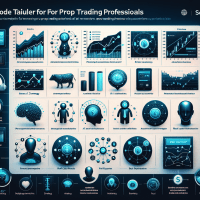Introduction to Prop Trading and AI-Driven Strategies
The modern prop trading landscape is evolving rapidly. Prop trading professionals now leverage advanced technology, data analytics, and AI-driven strategies to maintain a competitive edge. This comprehensive guide compares two innovative trading platforms, Solvent.Life and Vantir, focusing on AI strategy versus AI feedback models. We will explore how each system integrates automated backtesting, risk management, and real-time analytics to empower both retail and institutional traders.
Why Advanced Backtesting is Crucial in Prop Trading
Accurate backtesting is the backbone of any robust trading strategy. In prop trading, where large capital and strict regulatory frameworks like MiFID II and ESMA guidelines govern operations, reliable backtesting systems help traders mitigate risks and fine-tune their strategies. Advanced backtesting environments help overcome challenges including overfitting, survivorship bias, and look-ahead bias.
Key Backtesting Pitfalls and Mitigation Strategies
Overfitting: When a model fits the historical data too closely, its predictive power may diminish on new data. Use out-of-sample testing to ensure robustness.
Survivorship Bias: Ensure data integrity by including all instruments, not just those that have survived till date.
Look-Ahead Bias: Simulate trading scenarios without using future data to maintain testing accuracy.
Figure 1: Screenshot of an AI trading dashboard showing backtesting metrics, scenario analysis and live monitoring features.
Deep Dive: Solvent.Life vs Vantir – AI Strategy vs AI Feedback Models
In this section, we provide an in-depth comparison of Solvent.Life and Vantir, two leading AI-driven platforms designed with prop trading in mind. Both tools offer unique benefits that cater to the needs of quantitative analysts, risk managers, and prop trading firm decision-makers.
Tool Comparison Table
| Feature | Solvent.Life (AI Strategy) | Vantir (AI Feedback Models) |
|---|---|---|
| Backtesting Approach | Vectorized and event-driven backtesting with automated parameter optimization and stress testing capabilities. | Emphasizes real-time feedback loops with historical simulation, incorporating scenario analysis and out-of-sample validations. |
| Data Depth & Quality | Robust historical data across asset classes, enhanced by integration with premium data feeds; supports tick and bar data. | High fidelity historical and real-time data feeds; excels in feedback using adaptive models to adjust for market shifts. |
| Integration Capabilities | Seamless API access, broker integrations with Interactive Brokers and MetaTrader 5; compatible with TradingView charts. | Integrates well with NinjaTrader and QuantConnect; offers API for broker and data platform integration for automated trading systems. |
| Pricing & Trials | Competitive tiered pricing with free trial options for prop firms; scalable collaboration features. | Flexible pricing with enterprise plans and trial periods aimed at institutional traders; enhanced compliance tools. |
| Prop Firm Suitability | Designed for extensive team collaboration and automated strategy optimizations, ideal for prop trading firms. | Offers robust feedback and continuous strategy tuning, suitable for both individual traders and prop firms requiring dynamic adjustments. |
Integrating Advanced Backtesting into Prop Trading Workflows
Successful prop trading strategies hinge on the effective integration of backtesting with forward testing methods. Walk-forward optimization presents an innovative alternative to traditional static backtesting, ensuring that strategies remain robust as market conditions evolve.
Walk-Forward vs. Traditional Backtesting
Walk-Forward Optimization: Models are tested over sequential time windows, adapting to market changes in real-time. This approach minimizes overfitting and ensures that strategies are agile in live trading environments.
Traditional Backtesting: Involves running historical data once without periodic recalibration, which might not account for structural market shifts.
Combining Backtesting and Forward Testing
Before live deployment, traders should integrate backtesting with paper trading regimes. By carefully monitoring metrics such as Sharpe ratio, maximum drawdown, and profit factor during forward testing, traders can refine their models and mitigate potential risks. An effective approach is to perform automated parameter optimization, followed by scenario-based stress testing.
Case Study: Effective AI Integration in a Prop Trading Firm
A leading prop trading firm, anonymized as Alpha Trading Group, integrated Solvent.Life’s AI strategy platform into their workflow. They initially faced challenges with overfitting and slow iteration times on new strategies. By leveraging automated parameter optimization and robust backtesting features, they improved their annual Sharpe ratio by 15% while reducing maximum drawdown by 10%. Conversely, another firm, Beta Capital, used Vantir’s dynamic feedback models to continuously adjust trading algorithms, resulting in faster adaptation to volatile market conditions and a 20% improvement in risk-adjusted returns.
Expert Guidance: Implementing Best Practices in Automated Backtesting
Below are some pro tips curated for prop traders aiming to enhance their testing and live deployment process:
- Mitigate Data Bias: Utilize high-quality tick data and cross-check multiple data sources to avoid biases.
- Optimize Parameters Effectively: Use automated optimization tools provided by platforms like TradingView and NinjaTrader to fine-tune models with minimal manual intervention.
- Utilize Out-of-Sample Testing: Always reserve a portion of your historical data for out-of-sample testing to validate your strategy’s robustness.
- Integrate Forward Testing: Before deploying live, use paper trading to simulate real market conditions and monitor key performance metrics such as Sharpe Ratio and drawdown thresholds.
Implementing Algorithms: A Practical Python Example
Below is an example snippet using Backtrader, a popular Python framework, to automate your backtesting process:
import backtrader as bt
class TestStrategy(bt.Strategy):
params = (('sma_period', 20), )
def __init__(self):
self.sma = bt.indicators.SimpleMovingAverage(self.data.close, period=self.params.sma_period)
def next(self):
if self.data.close[0] > self.sma[0]:
self.buy()
elif self.data.close[0] < self.sma[0]:
self.sell()
if __name__ == '__main__':
cerebro = bt.Cerebro()
cerebro.addstrategy(TestStrategy, sma_period=20)
data = bt.feeds.YahooFinanceData(dataname='AAPL', fromdate=datetime(2020,1,1), todate=datetime(2020,12,31))
cerebro.adddata(data)
cerebro.run()
cerebro.plot()
This script demonstrates how to implement a simple moving average strategy that can be expanded with more advanced features, including automated stress testing and optimization integrations with platforms like MetaTrader 5 and QuantConnect.
Internal Resources and Next Steps
For further reading on refining your prop trading strategies, check out our detailed guides on Advanced Prop Trading Strategies and Risk Management in Prop Trading. These resources provide a deeper dive into systematic trading, multi-asset class integration, and compliance best practices.
Figure 2: Backtesting report example from Vantir showcasing drawdown, Sharpe Ratio, and trade performance metrics.
Regulatory Considerations in Prop Trading
Successful prop trading requires staying compliant with financial regulations. Understand guidelines set by MiFID II, ESMA, and NFA, which demand rigorous risk management protocols and transparent reporting. Platforms like Solvent.Life and Vantir often include features designed with these regulations in mind, such as detailed audit trails and compliance toolkits.
Conclusion and Call to Action
Both Solvent.Life and Vantir offer innovative approaches to automated AI trading, each tailored for distinct aspects of trading strategy formulation and risk feedback. Whether you prioritize streamlined AI strategy development or require real-time feedback to adapt quickly, this guide has provided actionable insights into maximizing your prop trading performance.
For a more detailed methodology and our exclusive Risk Management Checklist, download the resource linked below and subscribe to our newsletter to stay updated on forthcoming webinars and advanced strategy sessions.
Risk Management Checklist
Key Items:
- Data Quality Verification
- Out-of-Sample Testing Procedures
- Stress Testing and Scenario Analysis
- Automated Parameter Optimization Metrics
- Compliance and Reporting Tools
This checklist is designed to ensure that your trading strategies are robust, scalable, and compliant with current industry standards.
As of







